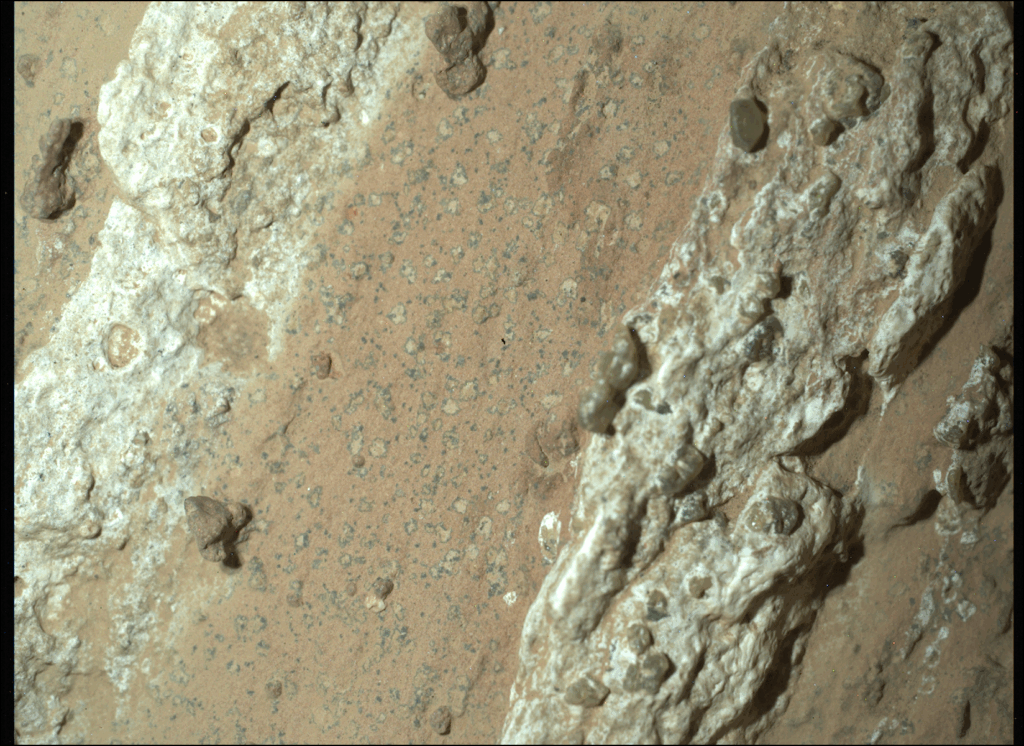Research & Developments is a blog for brief updates that provide context for the flurry of news that impacts science and scientists today.
A sample collected in July 2024 by NASA’s Perseverance Mars rover may be “the closest we’ve actually come to discovering ancient life on Mars,” according to Nicky Fox, the science head of NASA.
In a press conference today, NASA officials shared new results of an analysis of a sample named “Sapphire Canyon,” the 25th sample Perseverance collected from Mars. The analysis was published today in Nature.
Perseverance has been looking for signs of life on the Red Planet since 2021, exploring the 28-mile-wide (45-kilometer-wide) Jezero Crater that, billions of years ago, repeatedly flooded with water. The crater’s past conditions mean it could have been a suitable habitat for microbial life.
The rover collected Sapphire Canyon from a vein of sedimentary rock in a river valley called Neretva Vallis that is situated in the crater. The rock bore a distinct, leopard-print pattern visible to the naked eye. “We hadn’t seen anything like that before on Mars,” Fox said at the press conference.

Perseverance has collected 30 samples in total from Jezero Crater. Though none of the samples have been returned to Earth, scientists have been able to study them via Perseverance’s on-board instrumentation. “We basically threw the entire rover science payload at this rock,” said Katie Stack Morgan, a Perseverance project scientist at NASA’s Jet Propulsion Laboratory and coauthor of the new study.
“When we see features like this in sediment on Earth, these minerals are often the byproduct of microbial metabolisms that are consuming organic matter.”
Scientists analyzed the sample’s leopard spots using the rover’s Scanning Habitable Environments with Raman & Luminescnece for Organics and Chemicals (SHERLOC) spectrometer and Planetary Instrument for X-ray Lithochemistry (PIXL) X-ray spectrometer. The analysis revealed the presence of organic matter in the mud that formed the rock, as well as the presence of iron-, phosphorus-, and sulfur-bearing minerals called vivianite and greigite in the leopard spots.
The combination of minerals and the organic matter in the mud indicated the past occurrence of chemical reactions that could have been driven by ancient microorganisms, said Joel Hurowitz, a planetary scientist at Stony Brook University and lead author of the new study.
“What’s exciting about this combination of mud and organic matter that has reacted to produce these minerals and these textures, is that when we see features like this in sediment on Earth, these minerals are often the byproduct of microbial metabolisms that are consuming organic matter,” Hurowitz said.
Hurowitz added that there are also abiotic processes that could have created the patterns detected in the rock, and that with Perseverance’s instrumentation it isn’t possible to rule out abiotic explanations.
NASA, in partnership with the European Space Agency, has been planning to develop the Mars Sample Return mission to eventually return samples collected by Perseverance to Earth, allowing scientists to get their hands on the rocks.
But budget changes have left the future of Mars Sample Return uncertain: President Trump’s May budget proposal suggested a $6 billion cut to NASA funding, including a proposal to “terminate unaffordable missions such as the Mars Sample Return.” Congress has not yet passed final appropriations bills and could still decide to allocate funding to Mars Sample Return.
Acting NASA Administrator Sean Duffy fielded multiple questions at the press conference about the future of Mars Sample Return. In his responses, he implied that human space exploration, a priority of NASA under Trump, could allow for the return of samples from Mars on a faster timescale with less expensive methods. That notion may be inconsistent with revised estimated costs of a fully robotic sample return mission compared with that of a human exploration mission to Mars.
“If we don’t have the resources for the right missions or the right people, I will go to the President, I’ll go to the Congress, I’ll ask for more money. But I feel pretty confident that with the money that we’ve been given in the President’s budget, we can accomplish our mission,” Duffy said.
—Grace van Deelen (@gvd.bsky.social), Staff Writer
These updates are made possible through information from the scientific community. Do you have a story about science or scientists? Send us a tip at [email protected].


